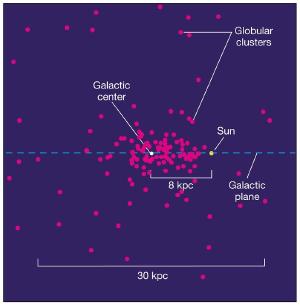Post
A Shapley Galaxy
13 September 2013
Locating the center of our galaxy has always been a bit of a challenge for several reasons. We can only view the portions of the galaxy that are visible from our vantage point, and since the central region is largely obscured by dust, any stars on the opposite side can’t be seen. We now know it is the center of the Milky Way that is dusty, but in the early 1900s all that was known was that there was a large dusty region preventing us from seeing further in that direction. Just how far the galaxy extended beyond that region wasn’t clear.
In the 1700s, William Herschel mapped the distribution of visible stars to determine the shape our galaxy. The result was a rather irregular distribution, and while Herschel had no way to determine the center of the Milky Way, he assumed the Sun was near the center. It was Shapley who, in 1918, demonstrated the Sun was not at the center of the Milky Way. Using a type of variable star known as RR Lyra, Shapely determined the distance to dozens of globular clusters. He then plotted their distances and directions to determine their distribution, as seen in the figure below.
 Christopher Palma
Christopher PalmaA globular cluster is dense, spherical cluster of stars. Their shape comes from the fact that they are clustered under their own gravity. They are not located in the plane of our galaxy, but instead are found in all directions. Because they aren’t confined to the galactic plane, distant ones are not usually obscured by the central dust region of our galaxy. And since they (like everything else in the galaxy) orbit the gravitational center of the galaxy, they are distributed so that their average (centroid) marks the center of the Milky Way.
Shapley’s calculation put the center of the Milky Way about 50,000 light years away from the Sun in the direction of Sagittarius. We now know that distance is closer to 27,000 light years, but Shapley was the first to demonstrate that the Sun was not the center of our galaxy (then thought to be the universe).
We finally knew the shape of our home.